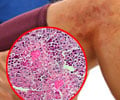Monitoring levels of exhaled nitric oxide in teenagers having asthma and adjusting treatment accordingly has no influence in improving the course of the condition, according to a new study.
Monitoring levels of exhaled nitric oxide in teenagers having asthma and adjusting treatment accordingly has no influence in improving the course of the condition, according to a new study.
Conducted by the Inner City Asthma Consortium (ICAC), the study of almost 550 adolescents from 10 cities across the United States, was led by Stanley Szefler, M.D., of National Jewish Health in Denver.The study aimed at examining whether in addition to treating asthma based on national guidelines, measurements of exhaled nitric oxide would allow even better control of the disease.
The new study was the largest till date for testing exhaled nitric oxide as a biomarker for asthma management.
Asthma is a chronic disorder of the airways and its is believed that allergens, air pollution and infections can provoke its symptoms, which include wheezing, chest tightness, shortness of breath and coughing.
Asthma symptoms occur when the tissues of the lungs become inflamed and the muscles in the airways contract, making breathing difficult.
High levels of nitric oxide (NO) in the breath are a measurable marker of asthma-related inflammation. It is known that the higher the exhaled NO, the greater the inflammation of the lungs. Equipment is now available to easily measure exhaled NO.
Advertisement
"A biomarker of airway inflammation could be a useful clinical tool for gauging medical needs and clinical responses in asthma patients. Although this study reinforces the importance of the NIH asthma guidelines for disease control, it did not find that measuring exhaled nitric oxide provided any additional clinical benefit," Lancet quoted Anthony S. Fauci, M.D., director of NIAID, as saying.
Advertisement
The researchers compared participants' symptoms and asthma exacerbations in the year-long study.
"The hypothesis was that adding exhaled NO monitoring to the NIH asthma guidelines-based approach would improve asthma control over the guidelines-based approach alone," said Szefler.
It was believed that exhaled NO would indicate if there was a need for increased treatment dosage in the participants having few asthma symptoms but who had ongoing high levels of lung inflammation.
However, the study found that the group whose treatment was guided by exhaled NO did not end up with fewer or less severe asthma symptoms or fewer asthma exacerbations compared with the group that received treatment based on the NAEPP guidelines alone.
Majority of patients in each group showed marked improvement in their asthma initially and throughout the study, highlighting the importance of optimizing asthma treatment according to the NIH guidelines.
According to Dr. Busse, the upside of the study is that "good adherence to the current guidelines [for treating asthma patients] can mean good disease management without the need for a biomarker."
The study is published in the latest issue of The Lancet.
Source-ANI
SRM














